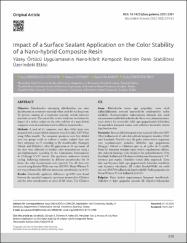Impact of a surface sealant application on the color stability of a nano-hybrid composite resin
Citation
Sarıalioğlu Güngör A, Dönmez N, Kahya DS, Hergüner Siso Ş. Impact of a Surface Sealant Application on the Color Stability of a Nano-hybrid Composite Resin. Bezmialem Science 2022;10(2):219-25.Abstract
Objective: Mouthwashes containing chlorhexidine can cause discoloration in restorative materials when used for the long-term. To prevent staining of a restorative material, several protective materials are used. The aim of this in vitro study was to evaluate the impact of a surface sealant on the color stability of a nano-hybrid composite resin material immersed in different mouthwashes.
Methods: A total of 42 composite resin discs (10x2 mm) were prepared with a nano-hybrid composite resin (Herculite XRV Ultra) using Teflon moulds. The composite specimens were first divided into two groups (with or without a surface sealant) then into three subgroups (n=7) according to the mouthwashes (Gengigel, Oderol, and Chlorhex). After SS application to 21 specimens, all the discs were subjected to baseline color measurements using a spectrophotometer according to the Commission Internationale de l'Eclairage L*a*b* system. The specimens underwent thermal cycling. Following immersion in different mouthwashes for 24 hours, the color measurements were repeated. The Delta E data were assessed using Kruskal-Wallis one-way ANOVA. Mann-Whitney U test was performed for different immersion mouthwashes (p<0.05).
Results: Statistically significant differences (p<0.05) were found between the unsealed composite specimens immersed in Chlorhex and the other mouthwashes in terms of.E values. The Chlorhex appeared to be associated with the most severe alteration in color (5.14 +/- 0.83), followed by Gengigel (2.21 +/- 1.46) and Oderol (1.94 +/- 1.75). There were no statistically significant differences (p>0.05) between the sealed and unsealed composite specimens in terms of the color changes.
Conclusion: The application of a low viscosity liquid surface sealant material did not show the expected effect on the color stability of a nano-hybrid composite resin in terms of three different mouthwashes. Amaç: Klorheksidin içeren ağız gargaraları, uzun süreli
kullanıldıklarında restoratif materyallerde renklenmelere neden
olabilirler. Restorasyonların renklenmesini önlemek için çeşitli
koruyucu materyaller kullanılmaktadır. Bu in vitro çalışmanın amacı,
yüzey örtücü bir materyalin farklı ağız gargaralarında bekletilmiş
bir nanohibrit kompozit rezinin renk stabilitesi üzerindeki etkisini
değerlendirmektir.
Yöntemler: Bir nano hibrit kompozit rezin materyali (Herculite XRV
Ultra) kullanılarak 42 adet disk şeklinde kompozit örnekleri (10x2
mm) hazırlandı. Örnekler önce iki gruba (yüzey örtücü uygulanan
veya uygulanmayan) ardından daldırılan ağız gargaralarına
(Gengigel, Oderol ve Chlorhex) göre üç alt gruba (n=7) ayrıldı.
Yirmi bir kompozit örneğine yüzey örtücü uygulamasını takiben,
tüm disklerin başlangıç renk ölçümleri bir spektrofotometre (Vita
Easyshade) kullanılarak Uluslararası Aydınlatma Komisyonu L*a*b*
sistemine göre yapıldı. Örneklere termal siklus uygulandı. Yirmi
dört saat boyunca farklı ağız gargaralarında bekletilen örneklerin
renk ölçümleri tekrarlandı. ∆E verileri Kruskal-Wallis tek yönlü
one-way ANOVA kullanılarak değerlendirildi. Farklı gargaralar için
Mann-Whitney U testi kullanıldı (p<0,05).
Bulgular: Yüzey örtücü uygulanmamış kompozit örneklerinde,
Chlorhex ve diğer gargaralar arasında ∆E değerleri bakımından istatistiksel olarak anlamlı farklılıklar (p<0,05) bulundu. Chlorhex,
en şiddetli renk değişikliğine neden olurken (5,14±0,83), Gengigel
(2,21±1,46) ve Oderol (1,94±1,75) onu takip etti. Renk değişimleri
açısından yüzey örtücü uygulanan ve uygulanmayan örnekler
arasında istatistiksel olarak anlamlı bir fark (p>0,05) bulunmadı.
Sonuç: Düşük viskoziteli sıvı bir yüzey örtücü materyalin
uygulanması, nano-hibrit bir kompozit rezinin renk stabilitesi
üzerinde, üç farklı gargara açısından beklenen etkiyi göstermedi.
Source
Bezmialem ScienceVolume
10Issue
2URI
https://cms.galenos.com.tr/Uploads/Article_51793/BezmialemScience-10-219-En.pdfhttps://hdl.handle.net/20.500.12780/665


















